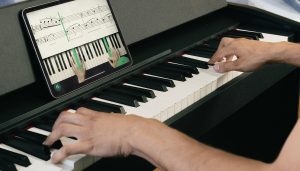Produced in 1970 and the title track of The Beatles’ twelfth and final album, Let It Be is one of the most iconic songs of all time. The Beatles are responsible for some of the most innovative, catchy pop music of the last century – their music has stood the test of time and still maintains that incredible sense of magic, fun, and simplicity.
This tutorial provides a step-by-step guide to learning this famous and well-loved song. We’ll take you through the technical side of things, including which piano keys to play and when as well as the well-known chord progression used in the song. We’ll also provide background into the theoretical and stylistic aspects of the song.
The lesson is geared towards beginner / intermediate pianists but even if you’re a more advanced player, there’s nothing to stop you learning the song and perhaps even trying to sing and play the melody at the same time!
Cheat sheet
| Artist | The Beatles |
| Composer | Paul McCartney |
| Release year | 1970 |
| Genre | Pop / rock |
| Difficulty level | Beginner – Intermediate |
| Instrument | Piano / voice |
| Key | C major |
| Meter | 4/4 |
| Techniques | 3-note chord playing in each hand |
”Let It Be” chords and progressions
In this tutorial we’ll introduce you to the piano chords of Let It Be, then teach you how to play the song using both hands. And once you’ve truly mastered this, maybe you can even try singing along as you play!
You’ll need to learn five chords to play the Let It Be sheet music: C major, G major, A minor, F major, and E minor. This may sound like a lot to remember but if you learn the song gradually, in small sections, you’ll have it mastered in no time!
The fingerings for the C major chord are relatively straightforward – depending on the size of your fingers you may choose one of the following fingerings:

As you can see, the fingerings of each hand mirror the other, making it easy to memorize. Try them out and see which one fits your hands better!
The other chords in the song all follow the same finger pattern, just using different notes. Once you’ve learned the finger pattern you should be able to easily apply it to the other Let It Be chords as long as you know the starting note. The G major chord begins on G, the A minor chord begins on A, and so on. And all of the chords in Let It Be use only white notes.
Below are diagrams of the other chords from Let It Be:


G major chord A minor chord


F major chord E minor chord

”Let It Be” lesson plan
Let It Be is one of the first songs that many budding musicians turn to when learning how to play the piano, and this interactive Skoove lesson gives you everything you need to get started with learning the song on piano.
Step 1: Listen to the song
It’s always a good idea to listen to the song in full so that you gain a good idea of what you’re working towards.
Step 2: Practice the Let It Be piano chords
Using the diagrams above to help you find the correct hand position, have a go at practicing the chords for Let It Be. Try each piano chord using separate hands to begin with and then see if you can play with both hands together.
Step 3: Learn the hand positions of the Let It Be chord progression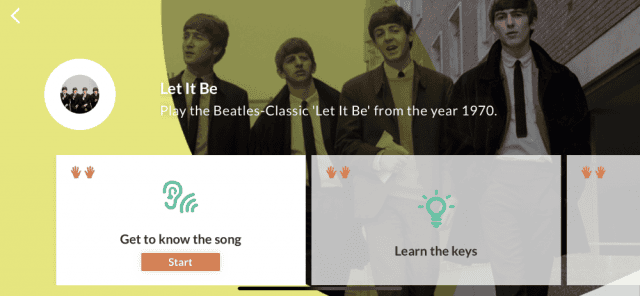
Carefully figure out the notes of each chord. At the beginning of the song it’s the right hand playing the chords, mostly in first inversion, with the left hand providing harmonic support in the bass line. Slow practice in the right hand as it jumps between the chords is crucial here! Check the hand positions shown below from the interactive app Skoove.
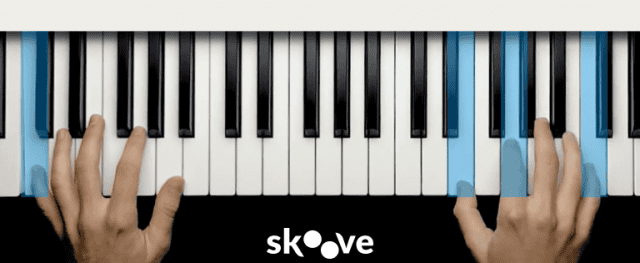
Hand position 1 (C major chord)
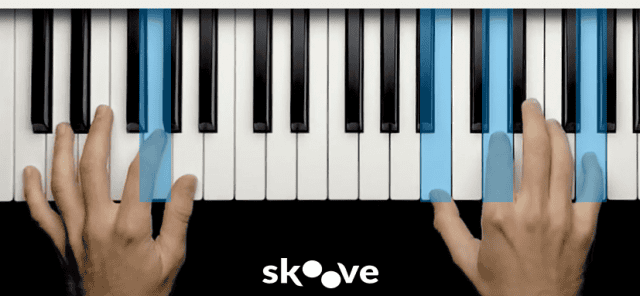
Hand position 2 (G major chord)
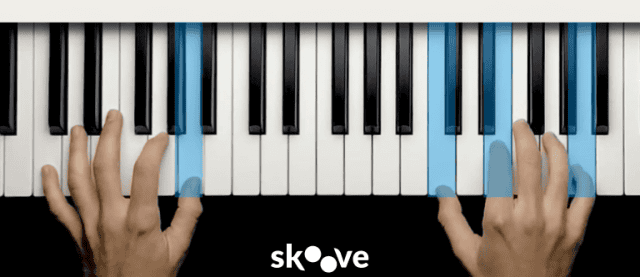
Hand position 3 (A minor chord)
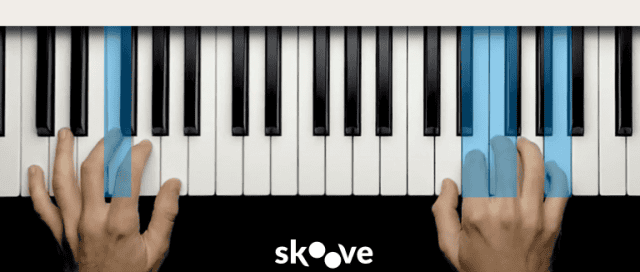
Hand position 4 (F major chord)
Step 4: Learn the keys
The next step is to smoothly alternate between the hand positions,making sure you play the correct notes. Don’t worry too much about the rhythm at this stage – playing the accurate piano keys is most important for now!

Step 5: Play in time
Only when you’re feeling super comfortable with the notes is it time to start playing the song in time. The backing click on the Skoove app is a fantastic way to keep track of your timing.
For the main melody section, where you have to play the tune in the right hand while playing chords in the left hand, it’s best to be really familiar with how the left hand part works first. You should almost be able to play the left hand without thinking about it before you start focusing on the right hand part.

Step 6: Extension exercise – spice up your chords!
If you’re looking to make Let It Be sound extra jazzy, or if you’re a more advanced player looking to expand your knowledge of piano chords, check out our lesson on harmonic tension below.
You can add some really cool-sounding chords to the tune to make it even more exciting and impressive!

Practice tips
Here are some great tips and things to remember when you’re starting out learning how to play Let It Be on piano.
- The song is in the key of C major, which means you don’t need to worry about too many sharps or flats. The time signature is 4/4, which means there are 4 four beats per measure.
- First start out by learning the left hand, then the right hand, and only when you’ve fully mastered this should you attempt to play with both hands together.
- The melody only uses one flat, a Bb, which is written into the sheet music. It comes towards the end of the song.
- Learn to feel your way through the notes in the right hand piano melody so that you don’t have to look down at the piano keys all the time. This will help you memorize the tune and be able to read the piano sheet music faster.
- Get the piano chord pattern into your muscle memory so that you can jump between the chords with ease.
Interesting fact
The words “Mother Mary” in the lyrics refer to McCartney’s mother. She died when he was 14 years old and appeared to him in a dream, saying “Everything will be alright – just let it be”.
Discover more from The Beatles
In this tutorial you’ve learned how to play one of the most beautiful songs written by The Beatles and an eternal favorite among pianists. Although the Let It Be piano notes might seem daunting at first, if you practice slowly enough initially and remember to fully master each hand separately before attempting to play with both hands at the same time you’ll find the learning process a lot easier.
And once you’re playing Let It Be on piano with ease, be sure to keep practicing and to check out the hundreds of other songs available for you to enjoy on the Skoove app. Why not give some of our classical piano songs a try? All lessons are accompanied by easy-to-follow tutorials and real-time feedback on your playing. Sign up for your free trial today!
Want to discover more Beatles’ songs? Check Skoove’s course and play your favourite Beatles’ songs.
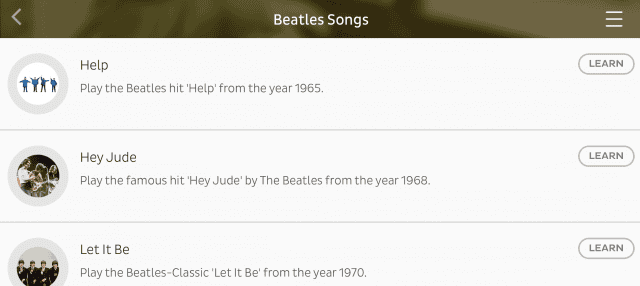
Author of this blog post:

Sam Girling is a percussion and piano teacher, writer, an researcher based in Münster, Germany and Auckland, New Zealand. He has performed extensively in New Zealand and Europe, lectures on a variety of music history and theory topics, and has published several academic articles and musical scores. Sam has taught music in a variety of contexts, from primary schools through to university level.








